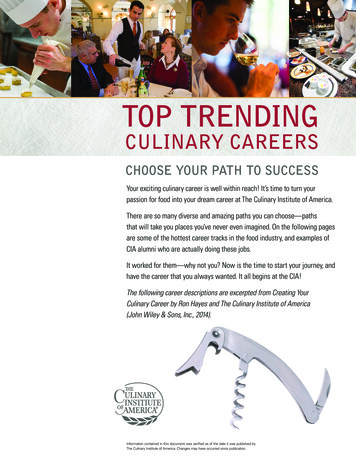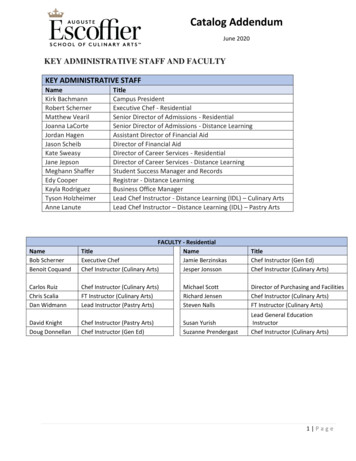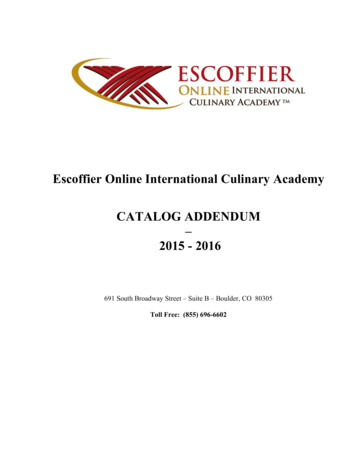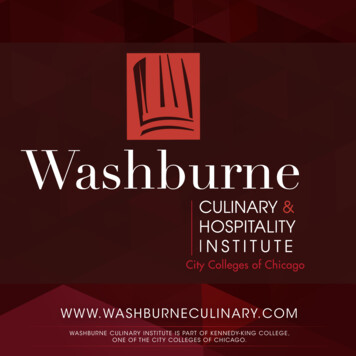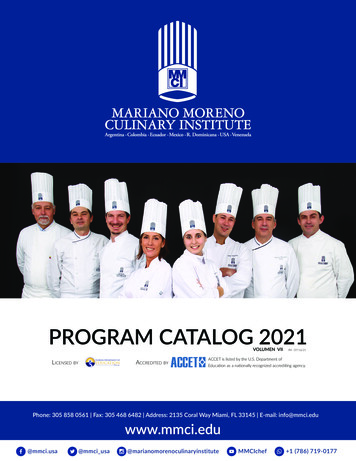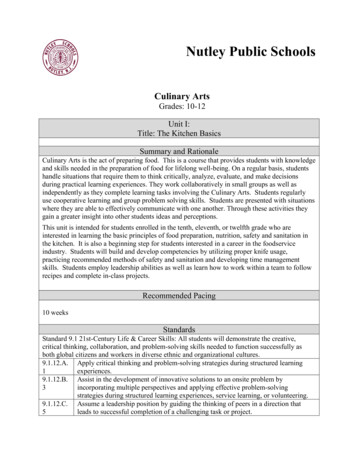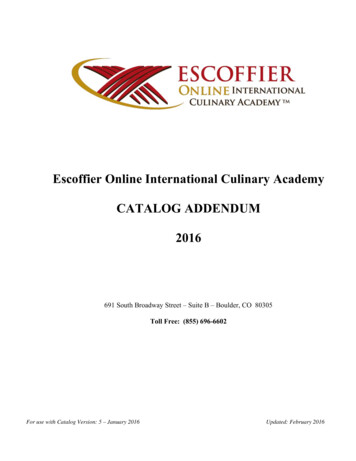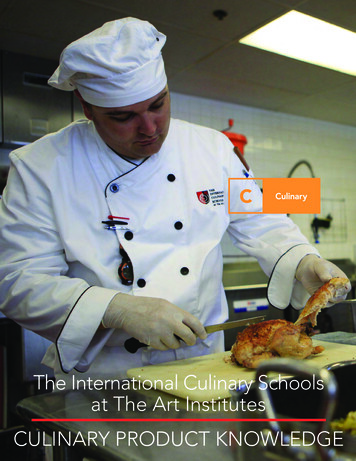
Transcription
The International Culinary Schoolsat The Art InstitutesCULINARY PRODUCT KNOWLEDGE
CONTENTS3Why The International Culinary Schools at The Art Institutes?3History of Restaurants3Kitchen Brigade4Restaurant Positions4Safety and Sanitation4Mise en Place: “To Put in Place”5Tools and Equipment10 Knife Skills11 Mother Sauces
Why The International Culinary Schools at The Art Institutes?Our program is rooted in the culinary tradition of over 35 International CulinarySchools. We are the largest system of Culinary Schools in North America.We are known to prepare students for the culinary industry by teaching them thefundamental cooking skills and critical “employability skills” necessary to succeed. Wealso introduce them to a range of world cuisines to promote greater cooking versatilityand creativity.History of RestaurantsRestaurant or Restaurer, meaning “to restore.”Restaurants are generally credited to 18th century France. The first French restaurantswere not fancy gourmet establishments run by ex-aristocratic chefs. They were highlyregulated establishments that sold restaurants (meat-based consommes intended to“restore” a person’s strength) to people who were not feeling well.Kitchen BrigadeThe Classic Kitchen Brigade was founded by August Escoffier, a great chef known fordefining the French cuisine and dining room during the 19th century. The brigadebreaks down a kitchen into several departments. These departments are what create akitchen from the fry station to the soup station. Each station plays a vital roll in anyrestaurant kitchen. There must be a well-qualified staff to run this system. Chef de Cuisine or Executive Chef -- Responsible for menu managemement,kitchen operations, and staffing kitchens properly. The Sous Chef -- Responsible for scheduling, replacing, and running any openstations. Aboyeur (ah-boh-yer) (Expediter) -- Responsible for calling out orders tostations and reviewing dishes from plate presentation. The Saucier (saw-see-yay) (Sautee Station) -- Creates all the sautéed items. The Poissonier (pwah-sawng-yay) (Fish Station) -- Responsible for any fishitems and their sauces. The Grillardin (gree-yar-dahn) (Grill Station) -- Creates all grilled items. The Friturier (free-too-ree-ay) (Fry Station) -- Responsible for all fried items. The Rotisseur (roh-tess-uhr) (Roast Station) -- Creates all roasted items and jussauces. The Potager (poh-tah-zaj) (Soup Station) -- Responsible for all soups andstocks. The Legumier (lee-goo-mee-ay) (Vegetable Station) -- Creates all vegetableand starch items. The Garde Manger (gahr-mohn-zahj) (Pantry Station) -- Responsible for allcold items from salads, appetizers, dressings, charcuterie, terrines, and pâtés.This chef also supervises the butcher. The Tournant (toor-nahn) (Roundsman) -- Works where needed.The Patissier (pah-tes-syay) (Pastry Chef) -- Creates all baked items frombreads, desserts, and pastries. Demi Chefs (Assistants) or Commis (kohm-ee) (Apprentices) -- Works withstation chefs to learn the area.3
Restaurant PositionsStudents need time to develop and hone their skills. Most students after graduation willstart at entry-level positions. Placement in a kitchen is typically as listed below (leastexperienced to experienced): Assistants or Apprentices -- Assigned where needed.Short Order Cooks -- Responsible for quickly preparing foods.Line Cooks -- Responsible for preparing menu items from a recipe.Relief Cooks -- Responsible for praparing foods on an hourly based schedule.Area Chef (Chef de Partie) -- Responsible for a specific facility or function.Demi Chef -- Works with station chefs to learn the area.Sous Chef -- “Sous ” is French for “under.” The Sous Chef is ranked directlyunderneath the Executive Chef. Sous Chefs assure the establishment issending ou the best quality food they can.They also help manage the staffand are responsible for food and labor costs associated with running thekitchen when the Executive Chef is away. Executive Chef -- Supervisors and coordinates the preperation of a menuand ensures all food items are prepared, portioned, cooked, garnished, andpresented properly. Also responsible for supervising the kitchen and producing menu items.Safety and SanitationSanitation is the creation of maintenance that will prevent food contamination or foodborn illness. Contamination is the presence of harmful organisms or substances whichare either biological, chemical, or physical.Mise en Place: “To Put in Place”Mise en Place is very simple, but often times, not taken seriously by line or relief cooks,as it is one of the most important elements in a kitchen. Mise en Place ensuresorganization and efficient food preperation. Mise en Place is considered to consist ofjust the right amount of tools to get the job done fast and efficiently, organization oftools and equipment, as well as products or ingredients, and cleaning tools, such assanitizer and towels. A good sense of Mise en Place is to be able to multi-task withgreat timing and work efficiently. For example, a chef with a good Mise en Place canthink about everything that needs to be done before ever starting work. Here are a fewtopics to think about when preparing a Mise en Place: Knives should be sharp and honed before starting work.Measuring devices should be checked for accuracy.All ovens and cooking devices should be turned on before starting work.Selecting proper equipment for any task.All serving ware should be ready for use and nearby.Foods should be ready and stored properly.All foods should have expiration dates.All stations should have sanitation buckets with designated towels.Properly measuring and preparing ingredients.4
The International Culinary School Supply KitKNIVESA knife is the most important tool in a chef’s toolbox. With a sharpknife, a chef can accomplish a wide variety of tasks more quicklyand efficiently than any machine. It is ideal to purchase a very goodto high-quality knife. Although high-quality knives are expensive,they will last many years with the proper care and attention. Whenpurchasing knives, search for knives that are very sharp with agood-sized spine and a very thin blade. One that iswell-constructed for easy handling, balance, as well as placementwithin your hand.TYPES OF KNIVES9” CHEF’S KNIFE - RIVETED10” WIDE BREAD KNIFE - MILLENNIAThis knife is used for chopping, slicing,and mincing. 8-14” long with a wideblade at the heel and tapers to a point.One of the most important andcommonly used knives in a kit.Usually, these knives are serrated to cutsoft bread without crushing it. An offsetserrated knife uses an offset handle toensure the cook’s knuckles don’t touchthe cutting surface when the blade hascut all of the way through the food.11” GRANTON SLICER - MILLENNIA7” FORK - LEGEND3-1/2” PARING KNIFE - GENESISKNIFE ANATOMYA slicer either has a rounded or pointedtip with a product or straight edge usedfor slicing cooked meats. This blade isflexible (straight) to serrated(non-flexible).This knife is used for detailed workcutting fruits and vegetables. 2-4” long.A two-pronged fork used to hold meatsteady while it is being carved.5
Cooking Utensils Included In The Culinary Kit10” SPATULAPLASTIC BOWL SCRAPERPOCKET THERMOMETERSWIVEL PEELERLARGE TONGS12” PIANO WHIP6
Cooking Utensils Included In The Culinary KitMEASURING SPOON SET12” EXOGLASS SPOON1” & 7/8” DOUBLE MELONBALLER16” PASTRY BAGCUT RULERFISH SPATULALONG NOSE PLIERSSLIP MAT7
Kitchen EquipmentGRILLS AND BROILERSOVENSSTEAMERSSALAMANDERSTypically used to prepare fish, meats,and poultry. Heat is suppliedunderneath a rack for a grill, and for abroiler, heat is supplied on top orabove the food product. A broiler issimilar to a salamander as well as arotisserie oven, except that a rotisserieoven has a revolving rack spinning infront of the heat source.Steamers are used to cook food veryrapidly and evenly by direct contactwith steam. They are available invarious models, such as pressure orconvection. Pressure steamers heatwater above boiling point in a sealedcompartment, thus increasing theinternal temperature of the oven at4-15 pounds per square inch. Aconvection steamer provides heat froman internal boiler and releases it overthe food products. This is great forcooking vegetables with minimal loss offlavor or nutrients and keeping foodproducts warm. They’re also useful forcooking fish or meat to retain moisture.Stovetops, ranges, and ovens are oftenthe most important cooking equipmentin any kitchen. They are powered bygas with open burners to supply quick,direct heat. Conventional ovens supplythe heat underneath the product.Convention ovens use an internal fan tocirculate the heat to cook foods fasterand evenly.The salamander broiler, sometimessimply referred to as a “salamander,” isa culinary utensil characterized by veryhigh temperature overhead infraredheating elements which may bepowered by either electricity or gas. Itis used primarily in professionalkitchens for overhead grilling orbroiling. It is also used for the toastingand browning of gratin dishes, as wellas melting cheeses onto sandwichesand desserts such as Crème Brulee.8
Jamie BissonnetteAssociate of Science, Culinary ArtsThe Art Institute of Fort Lauderdale, 19962014 James Beard Award WinnerBest Chef, NortheastKitchen EquipmentDEEP FRYERSDeep fat fryers are sized by how muchhot oil they can hold. Most commercialdeep fryers range from 15-82 lbs andcan either be electrically or gas heatedwith heat temperatures ranging from200-400 degrees.DECK OVENSDeck ovens are designed to have oneor more baking chambers to allow largevolumes of products to be baked. Eachchamber has a floor (deck) upon whichfood is cooked. Some deck ovens use astone hearth for the cooking surface.Heat is created through elements andburners located at the top and bottomof the chamber. The chamber’scomponents (floor, walls, and ceiling)absorb heat and radiate that heat back,allowing an even cooking temperature.PROOF BOXESProof boxes are sealed spaces thatprovide an environment for which youcan control the temperature andhumidity. This way, yeast-risen bakedgoods can rise more effectively.9
Classic Knife CutsCHIFFONADE (chef-fon-nahd)Finely sliced or shreds of leafyvegetables or herbs1/8”x1/8”x2” (aka. allumette)JULIENNE (ju-lee-en)SMALL DICERONDELLES (ron-dells)BATONNET (bah-toh-nah)MEDIUM DICEOBLIQUE CUTSFINE BRUNOISE (broo-nwaz)LARGE DICEFINE JULIENNE (ju-lee-en)BRUNOISE (broo-nwah)PAYSANNE (pahy-sahn)Disc shaped slicesSmall pieces with two-angle cut ��x1/2”x1/8”10
Mother SaucesBECHAMELIt is traditionally made by whiskingscalding milk gradually into a whiteflour and butter mixture called roux.HOLLANDAISE SAUCEThis is an emulsion of egg yolk andbutter, usually seasoned with lemonjuice, salt, and a little white pepper orcayenne pepper. In appearance, it islight yellow and opaque, smooth, andcreamy.VELOUTÉ SAUCEThe ingredients of a velouté are equalparts by mass butter and flour to formthe roux, a light chicken, veal, or fishstock, and salt and pepper for seasoning.TOMATO SAUCEThis sauce comprises a wide variety ofsauces made primarily out of tomatoes,usually to be served as part of a dishrather than as a condiment.ESPAGNOLE SAUCEThis sauce is typically prepared fromvegetables and herbs that are cooked in abrown roux (flour and butter mixture), towhich a dark stock (veal or beef) andtomato purée are then added. The sauce isleft to simmer for around two hours until itreduces to a thick brown sauce. The finalstage is to pass the sauce through a sieve,which will retain all of the vegetables,lumps, and unwanted ingredients.11
Since The Art Institutes is comprised of several institutions, see aiprograms.info for program duration, tuition, fees, othercosts, median debt, federal salary data, alumni success, and other important info.The Art Institutes is a system of over 50 schools throughout North America. Programs, credential levels, technology, andscheduling options vary by school and are subject to change. Several institutions included in The Art Institutes system arecampuses of South University or Argosy University. Administrative office: 210 Sixth Avenue, 33rd Floor, Pittsburgh, PA 15222 2014 The Art Institutes International LLC 052814
FattoushToasted Bread Salad serves 4PROCEDURE1Combine all ingredients and toss with salad dressing.Salad DressingPROCEDURE1Mash garlic with salt and stir in remaining ingredients.(The International Culinary Schools at The A. International Cuisine. John Wiley & Sons, 06/2008.VitalBook file.) Michael Nenes.The International Culinary Schools at The Art Institutes is North America's largest system of culinary programsoffered at over 40 Art Institutes schools. Administrative office: 210 Sixth Avenue, 33rd Floor, Pittsburgh, PA 15222 2014 The Art Institutes International LLC. See aiprograms.info for program duration, tuition, fees, and other costs,median debt, federal salary data, alumni success, and other important info
The International Culinary School Supply Kit KNIVES A knife is the most important tool in a chef's toolbox. With a sharp . Associate of Science, Culinary Arts The Art Institute of Fort Lauderdale, 1996 2014 James Beard Award Winner Best Chef, Northeast Jamie Bissonnette. 10 Classic Knife Cuts


